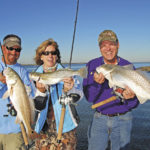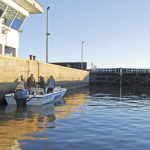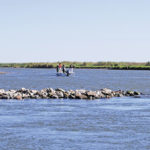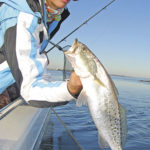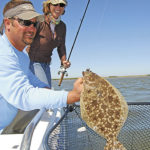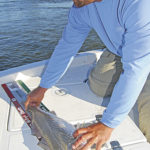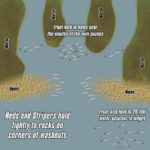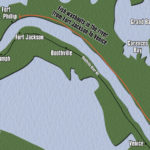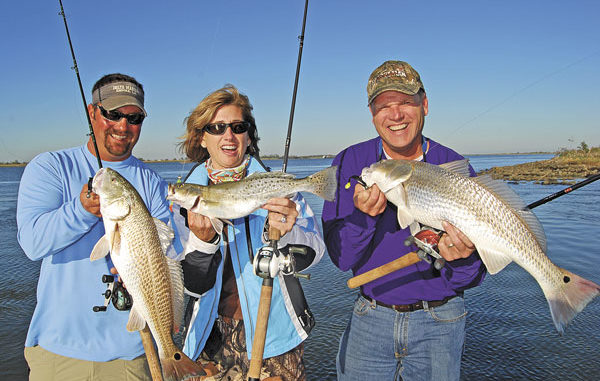
Autumn’s other name means something entirely different for anglers who fish the Mississippi River from Empire south.
Luke Landry’s favorite color is green.It is the color of money and of envy, but more importantly to Landry, it is the color the lower Mississippi River gets this time of year.
By the time the sun slides out of the Northern Hemisphere and turns its searing gaze toward places like Australia and New Zealand, North America’s spring torrents have drained from the continent and summer’s snow melt is but a memory. Docile weather is the rule from California to Maine and Florida to Washington.
The Mississippi River, nothing more than a gigantic drainage ditch, loses the roiling energy that gave it such life only months earlier. Down near its mouth, the waters that Landry loves to ply, the reduced flow sparks an amazing chain of events that ultimately leaves anglers with sore arms and smiling faces.
From its headwaters in Minnesota all the way to just past Baton Rouge, the Mississippi River declines in elevation as it seeks to rid the continent of its excess water. After Baton Rouge, however, the river almost bumps into itself.
Centuries of alluviation from the river turned open water into land below the town the French named “Red Stick,” but that land is just about as flat as the recent economy.
Consequently, the river after Baton Rouge doesn’t really “fall” to the Gulf; rather, it is pushed. The force of the water upstream nudges the water past Baton Rouge and, eventually, out into the Gulf through Southwest, South, Grand and other lesser passes.
But when the dry conditions that are part of this continent’s late-summer climate make their annual appearance, the flow of water upstream becomes a relative trickle, and the push of the water to the Gulf is like a 5-year-old girl trying to get through Jammal Brown to Drew Brees.
The Gulf wins that battle every time.
As it does, green, salty water pushes in a great wedge up the Mississippi River with such force that it has, at times, threatened the potability of New Orleans’ drinking water.
That wasn’t the case last year, when the continent stayed wetter than usual all the way into the early fall, but finally, by the end of October, the great migration of seawater up the river began, and with it came the complementary host of sealife.
Landry, who was on the water almost every day at the time, was one of the first to discover it.
A guide for his brother Lloyd’s Outcast Fishing Charters (504-912-8291), Landry tracked the fall of the river at www.lasmag.com, and knew during the third week of October that things would soon be right. He fished the river every day, and watched as the chocolate brown of the sweet water relented in painstaking increments to the sparkling green beautifulness of the Gulf.
Finally, on Oct. 29, the wedge pushed sufficiently through Landry’s favorite haunts, and the trout were thicker than kids on Halloween candy.
The next day, Landry took Louisiana Sportsman Publisher Tony Taylor, his wife Ann and me out to get in on a share of the action.
A late sunrise and a later arriving crew meant a late start for the anglers. But Landry felt not the least amount of apprehension or concern about missing the dawn bite.
“The river’s full of fish,” he said. “Once they show up, they’re here.”
By the time his Skeeter bay boat pulled away from the immaculate dock at Delta Marina, a sleepy autumn sun had begun to drag the mercury out of the 40s where it had spent the night. It was a chilly morning, but the clear blue skies would put up little resistance against that awakening sun, and the day held promise of just the right amount of warmth.
Landry idled the big boat east, and stopped inside of the Empire Lock.
“Going for a repeat of yesterday?” the attendant asked.
Landry nodded, and beamed a knowing smile.
When the back side of the lock was closed, the front side opened, revealing a river whose level was a mere inch or two above what was in the lock.
“That’s quite a difference from this spring,” Landry said, referencing the months when the Big Muddy was so high the Bonnet Carre Spillway had to be opened upstream. “By the time the river would fill the lock, your boat would be just about as high as the lock walls.”
The river side of the lock slowly, methodically opened, and Landry putt-putted out before pushing his throttle to the limit on the nearly calm river.
While passing Fort Jackson, he pointed to his right.
“At that channel marker right there, the water falls off from 3 feet down to about 25,” he said. “That’s always a great spot, but we fished it yesterday and didn’t get a bite. Give it another few days, and they’ll be stacked up there.”
Landry’s destination wasn’t too much farther south from the old fort. Just minutes later, he slowed to idle, and slipped through a washout in the river’s eastern rock wall. Just outside the break, he dropped anchor along the south side of the channel.
“If you cast toward the rocks, you’ll get mostly reds and stripers,” he said. “If you cast away from the rocks, you’ll catch more trout.”
First cast of the day went toward the rocks, and sure enough, it was a rat red. Second cast went away from the rocks, and it was a surface-thrashing speckled trout.
We sat there and caught fish after fish, and left them biting to check other areas, all of which produced similar results.
Such scenes play out every year at this time on the lower Mississippi River. The exact timing, of course, depends on the height of that river. Like a market analyst poring over a stock ticker, Landry in mid summer begins studying the river levels all the way up the continent checking for subtle changes. When consistent drops at places like Cairo, Memphis and Paducah aren’t followed by rises, he knows good things are in store for Southeast Louisiana anglers. Before long, the river will be at acceptable levels at New Orleans’ Carrollton gauge.
“You want that river to get below 4 feet and stay there,” he said. “Below 3 feet is really good.”
When such depths occur early in the season — July, August and September — the river bite is almost exclusively redfish.
“If it’s still hot and the river gets low, you will just pound the redfish, with an occasional trout,” Landry said. “It’s not until the full moon of October that the trout move in.”
But once they do, it’s not a trickle but an avalanche.
And Landry’s friends — at least those who have to work day jobs — turn the color of the river water.
